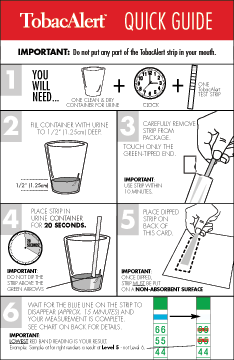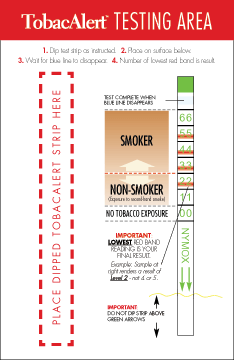TobacAlert

How it works
The end of the TobacAlert™ strip contains gold particles coated with an antibody that selectively binds to cotinine in the urine. After the end of the strip is dipped in urine, the gold particles migrate through specialized “traps” in the strip. The more cotinine bound to a gold particle, the further it is able to migrate along the strip. The reddish bands seen on the developed strip correspond to gold particles caught in a particular trap. TobacAlert™ is extremely sensitive and can measure amounts as low as 6 nanograms of cotinine per milliliter of urine (6 billionths of a gram in one fifth of a teaspoon).
Urine Test Kit
The urine test kit contains a test strip, a detailed product insert and a plasticized card. The card outlines simple instructions and provides a non-absorbent surface to lay the strip on while performing the test.Urine does not need to be processed, nor does it need to be "first morning" or "mid-stream". It does need to be clear and at room temperature. The tip of the test strip is dipped (not beyond the arrows), for 20 seconds and ten placed on the area indicated on the plastic card. After 15-20 minutes when the blue line at the strip's top disappears the test can be read.
Saliva Test Kit
The saliva test kit contains a test strip, a small funnel, a collection tube and a specialized filter cap.
Saliva is spit through the funnel into the tube. The filter cap is placed on the tube and the tube is squeezed until 8 drops have been placed on the end of the strip (indicated by arrows). The strip is then laid on a non-absorbent surface to develop for about 15 to 30 minutes.
It is important to recognize that it is the same test strip for both applications. What differs is the nature of the fluid being tested.
We can only sell to Medical Professionals
| Call For pricing (800-452-8909) |
|
| Call For pricing (800-452-8909) |
|


Click here for a larger image Click here for a larger image
/Click here forTobacAlert Questions and answers
What is TobacAlert?
TobacAlert™ is a home test that provides you with a quick, accurate, on-the-spot determination of a person’s level of exposure to tobacco products including second hand smoke. It is not intended for medical use.
TobacAlert™ is an easy to use, fast and accurate urine test strip. It can detect exposure to second hand smoke and the use of cigarettes, pipes, cigars, chewing tobacco.
TobacAlert™ measures levels of cotinine, a byproduct of the body’s breakdown of nicotine, the active ingredient found in tobacco products and tobacco smoke. Cotinine is a widely accepted indicator of recent tobacco product use and exposure, including second hand smoke exposure.
Primary Uses
Detection of recent second hand smoke exposure. Potential users include parents of young children, workers in a smoky workplace and other persons concerned about the harmful effects of second hand smoke.
Detection, verification and monitoring of tobacco use status. Potential users include smokers trying to quit, parents worried about whether a teenaged child may be smoking, coaches, insurance companies and smoking cessation counsellors.
NOTE: TobacAlert™ is for non-medical use. TobacAlert™ is not intended to diagnose treat or prevent any disease or medical condition.
How it works
The end of the TobacAlert™ strip contains gold particles coated with an antibody that selectively binds to cotinine in the urine. After the end of the strip is dipped in urine, the gold particles migrate through specialized “traps” in the strip. The more cotinine bound to a gold particle, the further it is able to migrate along the strip. The reddish bands seen on the developed strip correspond to gold particles caught in a particular trap. TobacAlert™ is extremely sensitive and can measure amounts as low as 6 nanograms of cotinine per milliliter of urine (6 billionths of a gram in one fifth of a teaspoon).
Saliva vs. Urine Cotinine Testing With TobacAlert
TobacAlert can be used to test the level of cotinine, a by-product of the body's breakdown of nicotine, in urine and saliva. Nicotine is the active ingredient found in tobacco products and tobacco use and exposure, including second hand smoke exposure.
TobacAlert Saliva vs. TobacAlert Urine Both tests:
1. Provide quick, accurate, on-the-spot determination of an individual's smoking status.
2. Measure the use of cigarettes, pipes, cigars and other tobacco products.
3. Measure nictotine intake from nicotine replacement sources such as patch, gum and lozenge.
4. Have been used medically and in research programs.
5. Can provide a positive incentive to people trying to quit or reduce tobacco intake by watching their levels drop
The urine test is ideal for lower levels of nicotine exposure and is sensitive enough to determine second hand smoke exposure. A reading of 1 typiclly points towards some passive smoke exposure. a reading of 2 indicates considerable passive exposure. A reading of 3 is normally the cut-off for determining if the subject is a smoker. Testing urine is also preferable for chewing tobacco studies.
The saliva test is suitable for situations where taking a urine sample is impractical or where the subject is a heavy user of tobacco products. A level of 1 typiclly indicates a smoker; so it is not suitable for examing second hand smoke exposure.
Testing Cotinine in Saliva vs. Urine
Some metabolites like cotine, become concentrated in urine, compared to levels found in saliva. Beacause of this, a readin g of 1 (6-30 ng/ml) for example, would normally indicate far more nicotine exposure if read from the saliva test, than from the urine test.
There is no fixed ratio of nicotine exposure when compairing urine to saliva readings (unless both tests have been performed on the same subject at the same time). The ratio of cotinine in saliva, to that found in urine could vary between individuals, gender, or the time that has been passed since the nicotine was ingested.
